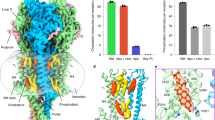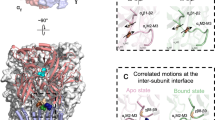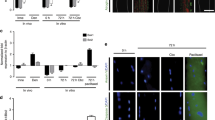Abstract
INACTIVATION of acetylcholinesterase (AChE) causes the half-decay times of the endplate currents (e.p.cs) and miniature e.p.cs (m.e.p.cs) to increase from about 1.5–2.0ms to 3.0–10.00 ms, times far too long to be accounted for by removal of the transmitter by free diffusion1–3. To explain this, Katz and Miledi1 postulated that, when the AChE is blocked, each acetylcholine (ACh) molecule undergoes numerous collisions with the post-synaptic membrane, leading to several attachments with the ACh receptors and a consequent delay in transmitter removal. This was supported by the observation that ( + )-tubocurarine, which reduces the number of free receptors, markedly decreases the half-decay of m.e.p.cs and e.p.cs after treatment with neostigmine1,3. In addition to this delaying mechanism, due to interaction with the ACh receptors the results described below suggest the existence of a second diffusion barrier for the transmitter at the frog neuromuscular junction. This barrier seems to be formed by non-depolarising sites which bind the ester moiety of ACh. Saturation of these sites with substances which possess –CO–O– or –CO–O–CO– groups accelerates the diffusion of externally applied ACh towards the ACh receptor, enhancing its depolarising effects. The barrier also hinders the outward diffusion of neurally released ACh in neostigmine-treated muscles, but this effect can only be demonstrated if the motor nerve is stimulated at high frequencies (200 Hz).
This is a preview of subscription content, access via your institution
Access options
Subscribe to this journal
Receive 51 print issues and online access
$199.00 per year
only $3.90 per issue
Buy this article
- Purchase on Springer Link
- Instant access to full article PDF
Prices may be subject to local taxes which are calculated during checkout
Similar content being viewed by others
References
Katz, B. & Miledi, R. J. Physiol., Lond. 231, 549–574 (1973).
Magleby, K. L. & Stevens, C. F. J. Physiol., Lond. 223, 151–171 (1972).
Magleby, K. L. & Terrar, O. A. J. Physiol., Lond. 244, 467–495 (1975).
del Castillo, J. & Sobrino, J. A. Int. J. Neurosci. 6, 67–75 (1973).
Saji, Y. & del Castillo, J. J. Neurosci. Res. 1, 437–457 (1975).
Eberson, L. Acta chem. scand. 18, 534–542 (1964).
Fatt, P. J. Physiol., Lond. 111, 408–422 (1950).
del Castillo, J. & Katz, B. Proc. R. Soc. B 146, 357–365 (1957).
Connor, J. A. & Stevens, C. F. J. Physiol., Lond. 213, 1–19 (1971).
Escalona de Motta, G. & del Castillo, J. Res. XIII Congreso Latinoamericanode Ciencias Fisioldgicas, México, D. F. 144, I.C.M.S.S. (1977).
Katz, B. & Thesleff, S. J. Physiol., Lond. 138, 63–80 (1957).
Author information
Authors and Affiliations
Rights and permissions
About this article
Cite this article
DE MOTTA, G., CASTILLO, J. Diffusion barrier for acetylcholine at the frog neuromuscular junction. Nature 270, 178–180 (1977). https://doi.org/10.1038/270178a0
Received:
Accepted:
Issue Date:
DOI: https://doi.org/10.1038/270178a0
Comments
By submitting a comment you agree to abide by our Terms and Community Guidelines. If you find something abusive or that does not comply with our terms or guidelines please flag it as inappropriate.



